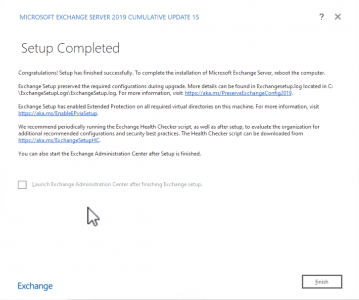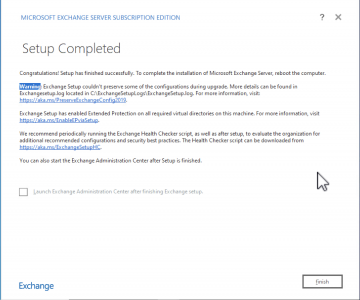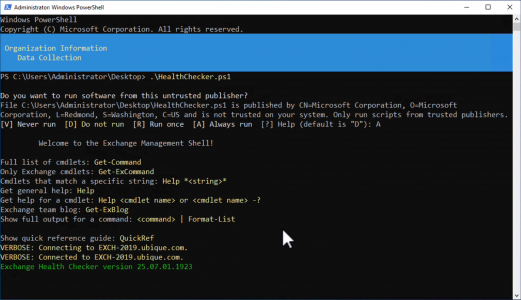Upgrading to Exchange SE KB ID 0001922
Problem
With ‘On-Premises” version of Exchange support coming to an end, anyone wanting to retain a ‘non cloud’ versions of Exchange should be upgrading to Exchange SE.
|
Exchange Version |
Mainstream End Date |
Extended End Date |
Support Status |
|
Exchange Server 2013 |
April 10, 2018 |
April 11, 2023 |
End of support |
|
Exchange Server 2016 |
October 13, 2020 |
October 14, 2025 |
In extended support |
|
Exchange Server 2019 |
January 9, 2024 |
October 14, 2025 |
In extended support |
|
Exchange Server Subscription Edition (SE) |
Modern – no fixed date |
OS lifecycle-dependent |
Ongoing – must stay updated |
By October 14, 2025, both Exchange 2016 and 2019 will leave support completely—with no security patches or fixes provided. If you’re on Exchange 2013, you’re already unsupported. The only fully supported on-premises version after October 2025 will be Exchange SE, assuming you’re on a supported Windows Server OS and keep up with the SE updates.
Solution
REMEMBER: If you’ve done Exchange upgrades before, this is a little different, for Exchange SE you IN PLACE UPGRADE A 2019 CU 14/15 SUPPORTED EXCHANGE SERVER, in the past you build a new Exchange server with the new version of Exchange then migrated mailboxes connectors, certificates etc. Note: If your on Exchange 2013 or 2016 you will STILL NEED TO DO THAT to get to Exchange 2019 (see table below).
Upgrading to Exchange SE Next Steps
Exchange 2013 users: Must migrate now—either to Exchange 2019/SE or Exchange Online.
Exchange 2016/2019 users:
-
Plan a migration before October 2025.
-
Recommended path: in-place upgrade to Exchange SE (if on 2019 CU14/15) or legacy upgrade to 2019 then SE.
-
Alternatively, consider moving mailboxes to Exchange Online or Microsoft 365.
Upgrading to Exchange SE Pre Requisites
Exchange 2019 CU14/15 (minimum), or Exchange 2016 CU23 (minimum)
-
Windows Server 2019, 2022, or 2025 (SE is tied to OS lifecycle)
-
.NET Framework 4.8+
-
Supported Active Directory:
-
Forest and domain functional levels: Windows Server 2016 or higher
-
Note: If you are on Exchange 2013 (any version), Exchange 2016 (before CU23), or Exchange 2019 (before CU14/15) you CANNOT UPGRADE.
|
From Version |
Action Needed |
Final Step to SE |
|
Exchange 2019 CU15 |
In-place upgrade |
Setup from SE ISO |
|
Exchange 2019 CU14 |
Update to CU14/15 → In-place upgrade |
SE install |
|
Exchange 2016 CU23 |
Install 2019 CU14/15 on new server → migrate mailboxes |
In-place upgrade to SE |
|
Exchange ≤2016 CU22 |
Update to CU23 → install 2019 CU15 → migrate |
In-place upgrade to SE |
Upgrading to Exchange SE Downloads
Note: It’s considered good practice, to ensure you do a full Windows update post Exchanger CU update.
Upgrading to Exchange SE
Check your CU level is correct for upgrade.
Get-ExchangeServer | Format-List Name,AdminDisplayVersion
Note: This will give you the build number, go to Exchange build Numbers to find the CU Level.
Upgrade as appropriate. (CU14/15 for 2019, or CU23 for 2016)
Perform a reboot, then have a cup of coffee while all the Exchange services restart, then recheck the build number is correct.
Then perform a IN PLACE UPGRADE of your Exchange with Exchange SE.
Post reboot, run the Exchange Health Checker Script.
Exchange SE Potential Upgrade Problems
Hybrid Mode Warning
Note: As with previous versions of Exchange, if you are in Hybrid Mode, then you need to make sure that Extended Protection Mode is disabled (or your EWS folder will not function correctly). You can do this by using;
setup.exe /Mode:upgrade /IAcceptExchangeServerLicenseTerms_DiagnosticDataON /DoNotEnableEP
Loss of Exchange Management Shell (EMS)
There have been some cases where post post-upgrade, you cannot access the Exchange Management Shell (the Exchange PowerShell management window). This happens because the virtual directory that IIS uses for PowerShell gets removed. You can recreate it with the following commands.
# Variables $ServerName = "EXCH-01" # Your Exchange server name $FQDN = "mail.petenetlive.com" # Your Exchange FQDN $WebsiteName = "Default Web Site" Write-Host "Removing existing PowerShell virtual directories on $ServerName (if present)..." -ForegroundColor Yellow # Remove existing (corrupt) PowerShell virtual directories Get-PowerShellVirtualDirectory -Server $ServerName -ErrorAction SilentlyContinue | Remove-PowerShellVirtualDirectory -Confirm:$false Write-Host "Creating new PowerShell virtual directory..." -ForegroundColor Yellow # Create the new PowerShell virtual directory New-PowerShellVirtualDirectory ` -Server $ServerName ` -WebsiteName $WebsiteName ` -InternalUrl https://$FQDN/PowerShell ` -RequireSSL:$true Write-Host "Applying authentication settings..." -ForegroundColor Yellow # Configure authentication methods Set-PowerShellVirtualDirectory -Identity "$ServerName\PowerShell (Default Web Site)" ` -WindowsAuthentication $true ` -BasicAuthentication $false ` -OAuthAuthentication $true Write-Host "Restarting IIS..." -ForegroundColor Yellow iisreset /noforce Write-Host "PowerShell Virtual Directory recreation complete on $ServerName." -ForegroundColor Green/pre>
Going Forwards
Important: Exchange SE CU2 (expected late 2026) will block coexistence with all older versions—including Exchange 2016 and 2019. So, all legacy servers must be removed before installing CU2
Long Term Support (Annnounced 08-05-25): Exchange SE EoS Date = 31-12/25 (reference).
Licensing: Although an upgraded Exchange 2019 server will retain its licence, Microsoft will be releasing more information about what you licensing will look like and what a ‘subscription’ will entail (as of 10/07/25). Reference.
SPLA: At time of writing (14-07-25) there has been no indication that Exchange SE will be avaiable under a SPLA agreement, I suggest you keep an eye on SPUR updates.
Related Articles, References, Credits, or External Links
NA




